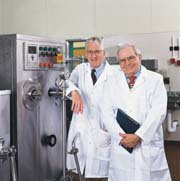
A: Body (i.e., structural characteristics) and texture (i.e., smoothness) have been discussed at length in previous columns, all of which can be revisited at www.onicecream.com. Improvement of body and texture means improved and/or novel management of water, ice, fat and air. More specifically, it means creating the smallest possible ice crystals, fat droplets and air cells, and controlling their growth after freezing, as well as managing fat agglomeration to provide target richness and creaminess characteristics.
Keys to creating products with superior body and texture include proper selection and use of ingredients; formulation elements; mix processing; freezing and hardening using conventional and not-so-conventional techniques; and protection from thermal abuse after packaging. In addition, novel approaches, techniques and ingredients can be used in more specialized frozen desserts such as no-sugar-added, lactose-free and low net-carbohydrate products to produce a product that resembles traditional ice cream.
Novel ingredients that might help include: Sources of low-lactose milk solids (filtered or lactase-treated dairy ingredients) to prevent sandiness and/or allow unusually high levels of MSNF; novel sweeteners including non-traditional water-soluble polysaccharides; high-molecular weight sugar alcohols; high-intensity sweeteners; and judicious selection and use of stabilizers and emulsifiers.
Processing approaches include using pasteurization to "pre-condition" the mix to immobilize more water; using homogenization to enhance the functionality of fat and other lipids in the mix; appropriate consideration and application of aging of processed mix; increasing air cell strength or using pre-aeration to minimize size of entrapped air cells; and rapid freezing both in the freezer and during hardening to reduce the size and maximize the number of ice crystals. Depending on the amount and type of ingredients used, more or less functionality in terms of water binding and holding could be created by managing the heat treatment (time/temperature) of dairy ingredients or during pasteurization of the mix.
The effect of homogenization on eventual body and texture features of the finished ice cream can differ due to factors such as mix composition, applied pressures, location of the homogenizer in the product flow, number of homogenization stages, temperature of homogenization, etc. Properly aged mix helps set the physical and chemical functionality of milkfat and any added emulsification and aids in water immobilization, whippability and freezing.
Pre-aeration of mix positively affects the firmness and stiffness of ice cream. The small air cells formed add significantly to the perception of creaminess, richness and smoothness while adding shape retention to the finished ice cream. Such mix processing approaches affect freezing, whipping, hardening and tolerance to distribution and thermal abuse. These, in turn, directly affect body and texture.
In general, the more water frozen in the freezer, the smaller the ice crystals will be when the ice cream is extruded. So, rapid freezing of mix to as low a temperature as practicable is critical to achieving smooth texture and a useful shelflife. A significant opportunity for body and texture improvement is now available in the form of equipment that can freeze ice cream at exit temperatures well below traditional freezer capabilities-as low as 5-10


